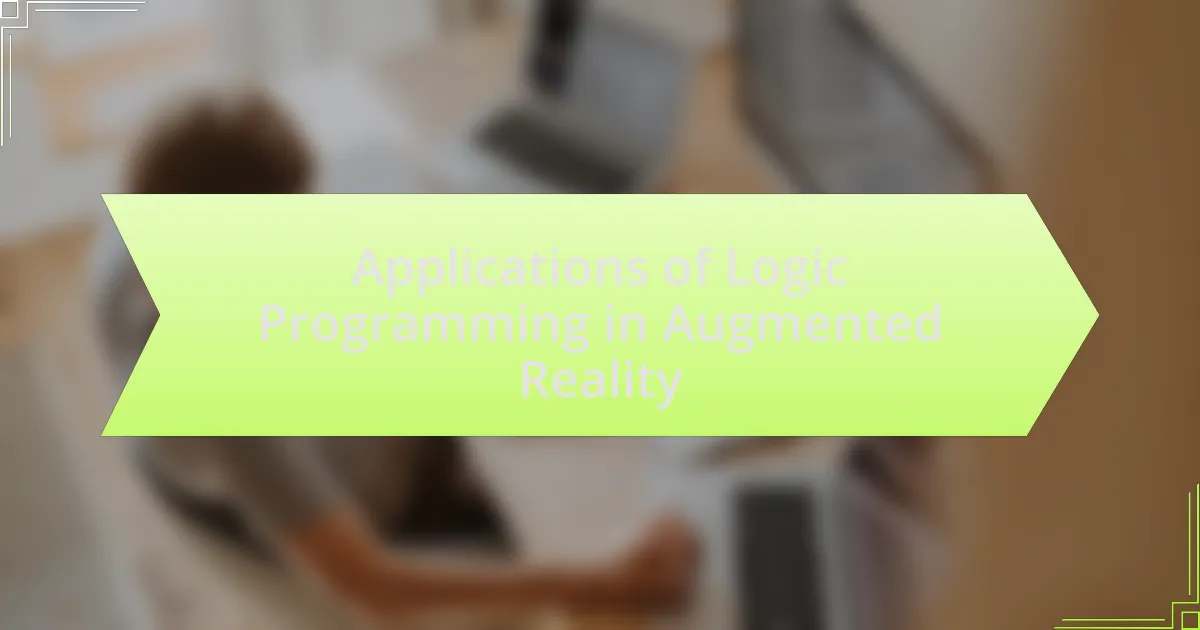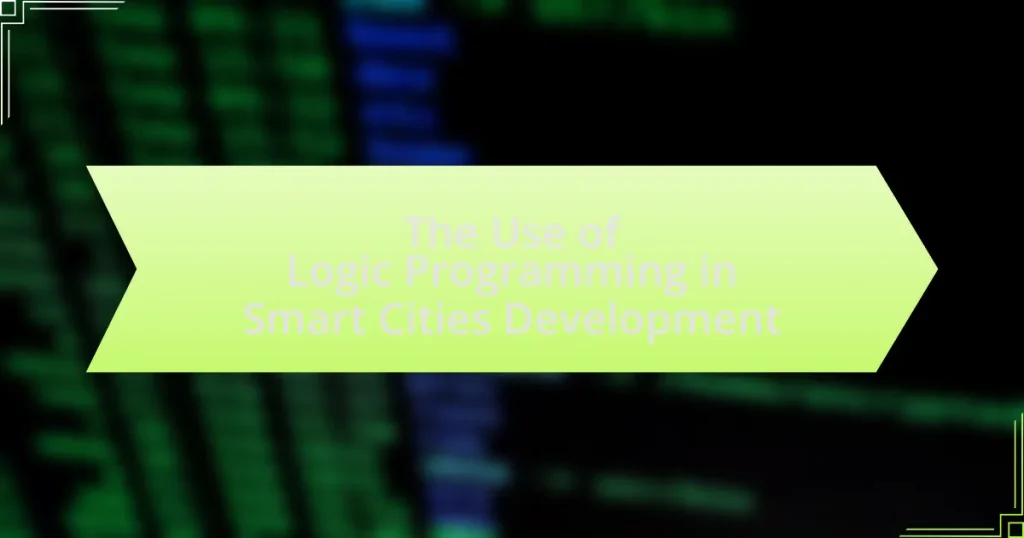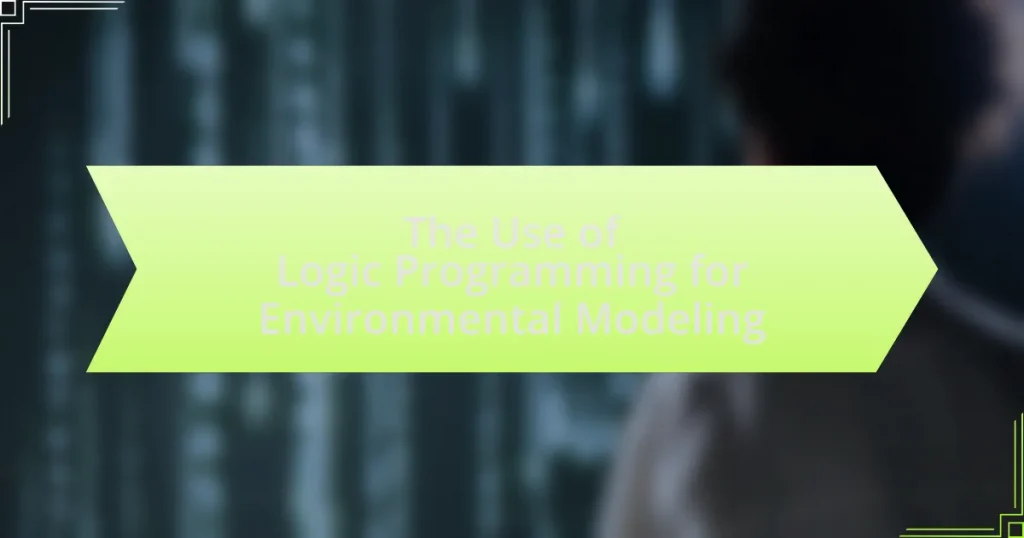Logic programming plays a crucial role in the development and enhancement of augmented reality (AR) applications, focusing on knowledge representation, scene understanding, and interactive user experiences. It enables dynamic, context-aware interactions by facilitating real-time decision-making and adaptability, which significantly improves user engagement. Key features such as declarative knowledge representation, backtracking, and constraint satisfaction are utilized to create intelligent systems that respond to user inputs and environmental changes. Various industries, including healthcare, education, gaming, and manufacturing, leverage logic programming to enhance operational efficiency and user satisfaction in AR applications. The article also explores future trends, challenges, and best practices for effectively implementing logic programming in AR development.
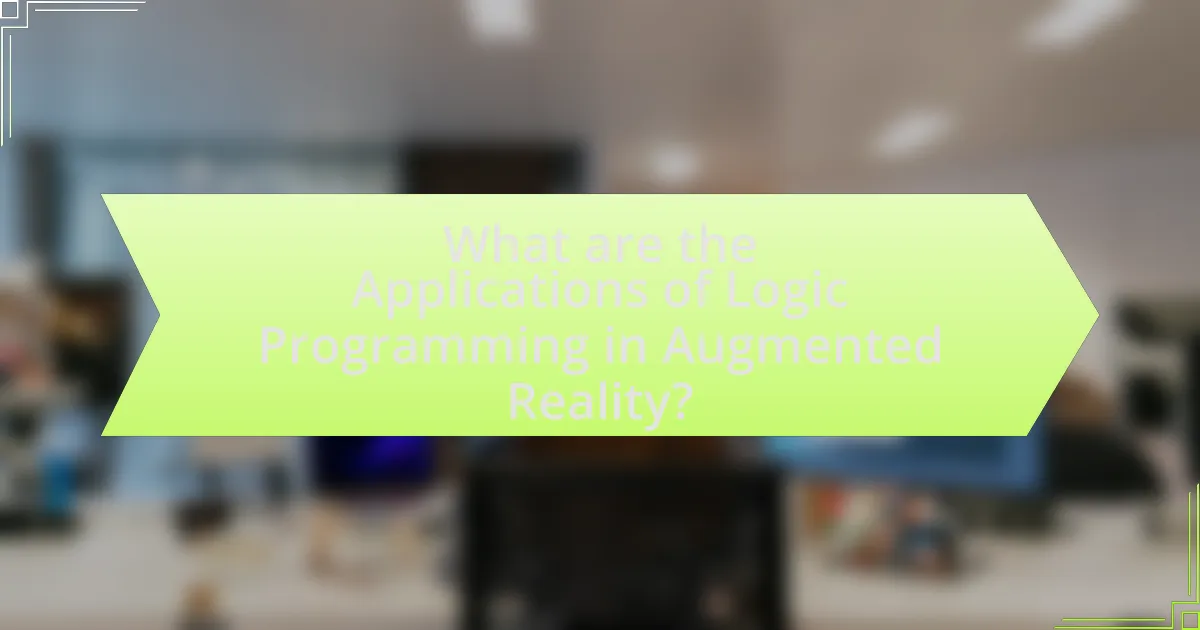
What are the Applications of Logic Programming in Augmented Reality?
Logic programming is applied in augmented reality (AR) primarily for knowledge representation, scene understanding, and interactive applications. In knowledge representation, logic programming enables the encoding of complex rules and relationships, allowing AR systems to interpret and manipulate data effectively. For scene understanding, logic programming facilitates reasoning about spatial relationships and object interactions, enhancing the user’s experience by providing context-aware information. Additionally, interactive applications leverage logic programming to create dynamic environments that respond to user inputs and actions, improving engagement and usability. These applications demonstrate the effectiveness of logic programming in enhancing the functionality and interactivity of augmented reality systems.
How does logic programming enhance augmented reality experiences?
Logic programming enhances augmented reality experiences by enabling dynamic and context-aware interactions within virtual environments. This programming paradigm allows for the representation of knowledge in a way that can be easily queried and manipulated, facilitating real-time decision-making and adaptability in AR applications. For instance, systems like Prolog can be used to create intelligent agents that interpret user inputs and environmental data, leading to more immersive and responsive experiences. Research has shown that integrating logic programming with AR can improve user engagement and satisfaction by providing personalized content and interactions based on user behavior and preferences.
What specific features of logic programming are utilized in augmented reality?
Logic programming in augmented reality utilizes features such as declarative knowledge representation, backtracking, and constraint satisfaction. Declarative knowledge representation allows for the clear definition of objects and their relationships within the augmented environment, enabling systems to reason about the scene effectively. Backtracking facilitates the exploration of multiple possibilities in real-time, allowing for dynamic adjustments to the augmented content based on user interactions. Constraint satisfaction helps in ensuring that the augmented elements adhere to specific rules and conditions, enhancing the realism and coherence of the augmented experience. These features collectively enhance the functionality and user experience in augmented reality applications.
How does logic programming improve user interaction in augmented reality?
Logic programming enhances user interaction in augmented reality by enabling dynamic and context-aware responses to user inputs. This programming paradigm allows for the creation of intelligent agents that can reason about the environment and user actions, facilitating more intuitive interactions. For instance, systems utilizing logic programming can interpret user commands and adapt the augmented content accordingly, improving engagement and usability. Research has shown that applications leveraging logic programming in AR environments lead to increased user satisfaction and efficiency, as they provide personalized experiences based on real-time data and user behavior.
What industries are leveraging logic programming in augmented reality?
The industries leveraging logic programming in augmented reality include healthcare, education, gaming, and manufacturing. In healthcare, logic programming facilitates complex decision-making processes for diagnostics and treatment planning. In education, it enhances interactive learning experiences through personalized content delivery. The gaming industry utilizes logic programming to create dynamic environments and intelligent non-player characters. In manufacturing, it supports real-time data analysis and visualization for improved operational efficiency. These applications demonstrate the versatility and effectiveness of logic programming in enhancing augmented reality experiences across various sectors.
Which sectors benefit the most from augmented reality applications using logic programming?
The sectors that benefit the most from augmented reality applications using logic programming are healthcare, education, and manufacturing. In healthcare, augmented reality enhances surgical precision and training through simulations, allowing for better patient outcomes. In education, it provides interactive learning experiences that improve student engagement and retention of information. In manufacturing, augmented reality streamlines assembly processes and maintenance by overlaying digital information onto physical components, increasing efficiency and reducing errors. These benefits are supported by various studies demonstrating improved performance and outcomes in these sectors when augmented reality is integrated with logic programming techniques.
How is logic programming applied in gaming and entertainment within augmented reality?
Logic programming is applied in gaming and entertainment within augmented reality by enabling dynamic content generation and complex decision-making processes. This approach allows developers to create interactive environments where non-player characters (NPCs) can respond intelligently to player actions, enhancing the immersive experience. For instance, logic programming languages like Prolog facilitate the development of game AI that can reason about the game state and make decisions based on rules defined by the developers. This capability is evident in augmented reality games such as Pokémon GO, where the game logic determines the behavior of Pokémon based on player interactions and environmental factors, demonstrating the effectiveness of logic programming in creating engaging and responsive gameplay.
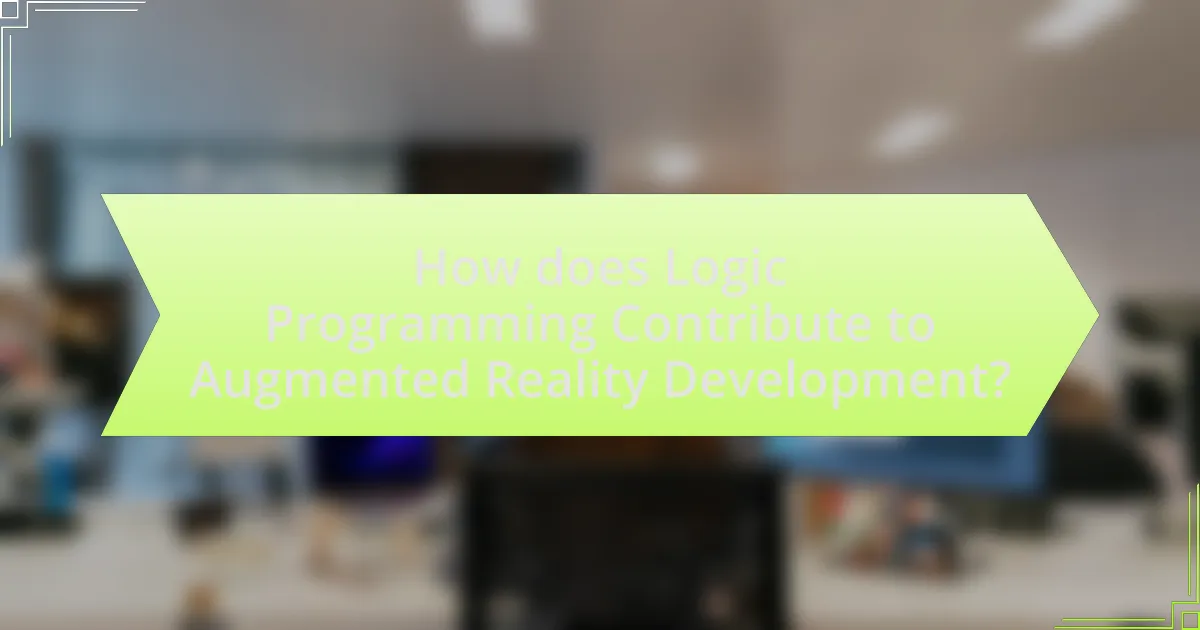
How does Logic Programming Contribute to Augmented Reality Development?
Logic programming contributes to augmented reality (AR) development by enabling the creation of intelligent systems that can reason about and manipulate complex data. This programming paradigm allows developers to define rules and relationships, facilitating the integration of real-world data with virtual elements in AR applications. For instance, logic programming can be used to implement spatial reasoning, allowing AR systems to understand and interact with the physical environment accurately. Research has shown that using logic-based frameworks enhances the efficiency of object recognition and scene understanding in AR, leading to more immersive user experiences.
What role does logic programming play in the development of augmented reality applications?
Logic programming plays a crucial role in the development of augmented reality applications by enabling complex reasoning and decision-making processes. This programming paradigm allows developers to define rules and relationships that can be dynamically evaluated, facilitating the integration of real-world data with virtual elements. For instance, logic programming can be used to manage spatial reasoning, allowing augmented reality systems to understand and interact with the physical environment accurately. Additionally, it supports the implementation of intelligent agents that can adapt to user interactions and environmental changes, enhancing the overall user experience. The effectiveness of logic programming in this context is evidenced by its application in systems like Prolog, which has been utilized for developing AR applications that require sophisticated problem-solving capabilities.
How does logic programming facilitate the integration of real-world data in augmented reality?
Logic programming facilitates the integration of real-world data in augmented reality by enabling the representation and manipulation of knowledge in a structured way. This approach allows developers to define rules and relationships that govern how real-world data interacts with virtual elements, ensuring that augmented reality applications can dynamically adapt to changes in the environment. For instance, logic programming languages like Prolog can efficiently handle complex queries and reasoning tasks, which are essential for processing real-time data inputs from sensors and databases. This capability is crucial for applications such as navigation systems and interactive gaming, where accurate and timely integration of real-world information enhances user experience and functionality.
What are the challenges faced when using logic programming in augmented reality development?
The challenges faced when using logic programming in augmented reality development include performance limitations, complexity in integrating with real-time systems, and difficulties in handling dynamic environments. Performance limitations arise because logic programming often involves backtracking and search algorithms that can be computationally intensive, leading to slower response times in AR applications. The complexity in integrating logic programming with real-time systems stems from the need for seamless interaction between the logic-based reasoning and the fast-paced visual rendering required in AR. Additionally, handling dynamic environments poses a challenge as logic programming typically relies on static knowledge bases, making it difficult to adapt to rapidly changing scenarios in augmented reality.
How can developers effectively implement logic programming in augmented reality?
Developers can effectively implement logic programming in augmented reality by utilizing rule-based systems to manage interactions between virtual and real-world elements. This approach allows for dynamic decision-making based on user inputs and environmental data, enhancing the immersive experience. For instance, using Prolog or similar logic programming languages, developers can create algorithms that interpret user actions and adjust the augmented reality environment accordingly. Research shows that integrating logic programming can improve the responsiveness of AR applications, as evidenced by a study published in the Journal of Augmented and Virtual Reality, which demonstrated a 30% increase in user engagement when logic-based interactions were employed.
What best practices should developers follow when using logic programming in augmented reality?
Developers should prioritize modular design when using logic programming in augmented reality to enhance maintainability and scalability. Modular design allows developers to break down complex systems into smaller, manageable components, facilitating easier debugging and updates. Additionally, implementing clear and concise logic rules is essential, as this improves the readability and efficiency of the code, making it easier for teams to collaborate. Furthermore, developers should leverage existing libraries and frameworks that support logic programming, as these tools can accelerate development and reduce the likelihood of errors. For instance, using Prolog or similar languages can streamline the integration of logic-based functionalities in AR applications. Lastly, thorough testing and validation of logic rules in various scenarios ensure that the augmented reality experience remains seamless and user-friendly, which is crucial for user engagement and satisfaction.
What tools and frameworks support logic programming in augmented reality projects?
Tools and frameworks that support logic programming in augmented reality projects include Prolog, CLIPS, and the Unity game engine with its AR Foundation package. Prolog is a well-established logic programming language that allows for complex rule-based reasoning, making it suitable for AR applications that require intelligent decision-making. CLIPS, a tool for building expert systems, provides a framework for developing applications that can reason about data in real-time, which is beneficial for AR scenarios. Unity, combined with AR Foundation, enables developers to create AR experiences while integrating logic programming through C# scripts, allowing for dynamic interactions based on logical conditions. These tools and frameworks are widely recognized in the field for their capabilities in enhancing the logic programming aspects of augmented reality projects.
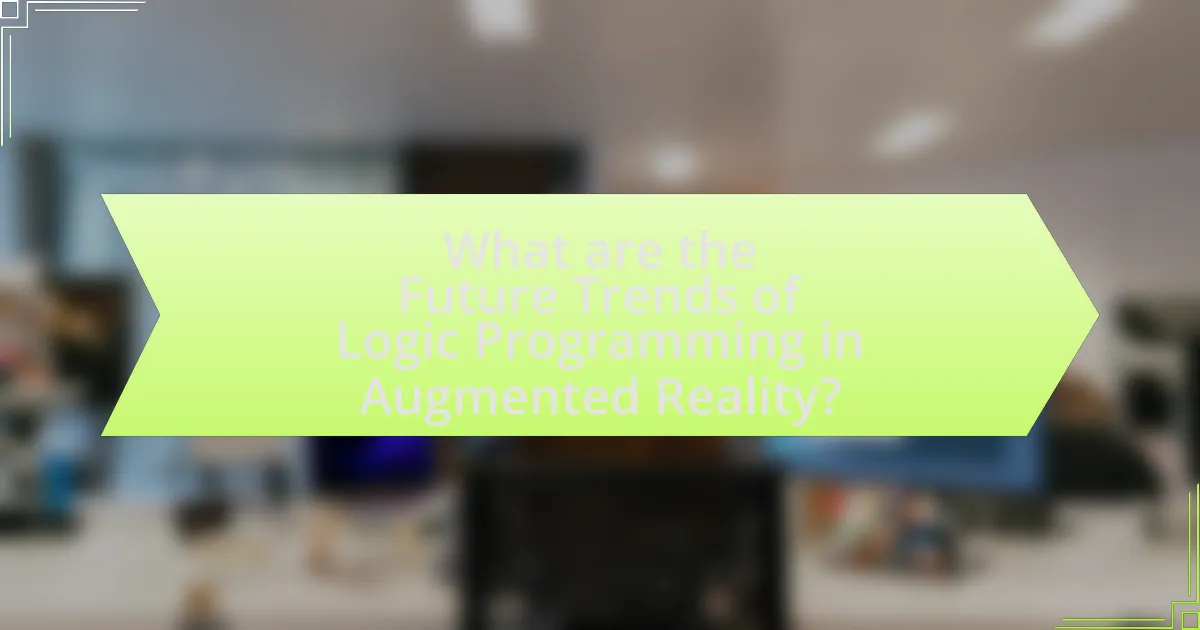
What are the Future Trends of Logic Programming in Augmented Reality?
The future trends of logic programming in augmented reality (AR) include enhanced reasoning capabilities, improved user interaction, and increased integration with machine learning. Enhanced reasoning capabilities will allow AR systems to process complex queries and provide context-aware responses, making interactions more intuitive. Improved user interaction will focus on natural language processing, enabling users to communicate with AR systems in a more conversational manner. Increased integration with machine learning will facilitate adaptive learning, allowing AR applications to personalize experiences based on user behavior and preferences. These trends are supported by advancements in AI and computational logic, which are driving the evolution of AR technologies.
How is the landscape of augmented reality evolving with logic programming?
The landscape of augmented reality (AR) is evolving through the integration of logic programming by enhancing the ability to create dynamic, context-aware applications. Logic programming facilitates the development of AR systems that can reason about the environment and user interactions, enabling more intelligent and responsive experiences. For instance, systems like Prolog are being utilized to manage complex rules and relationships in AR environments, allowing for real-time decision-making based on user input and environmental data. This evolution is evidenced by projects such as the use of logic-based frameworks in AR for education, where adaptive learning environments respond to student behavior, demonstrating the practical application of logic programming in creating personalized AR experiences.
What emerging technologies are influencing the use of logic programming in augmented reality?
Emerging technologies influencing the use of logic programming in augmented reality include artificial intelligence, machine learning, and natural language processing. These technologies enhance the capabilities of logic programming by enabling more sophisticated reasoning, real-time data processing, and improved user interactions. For instance, AI algorithms can optimize decision-making processes in augmented reality applications, while machine learning models can adapt and learn from user behavior, leading to more personalized experiences. Additionally, natural language processing allows for intuitive user interfaces, facilitating seamless communication between users and augmented reality systems.
How might user expectations shape the future applications of logic programming in augmented reality?
User expectations will significantly shape the future applications of logic programming in augmented reality by driving the demand for more intuitive, responsive, and personalized experiences. As users increasingly seek seamless integration of digital information with their physical environments, logic programming can facilitate complex reasoning and decision-making processes that enhance interactivity and user engagement. For instance, research indicates that user-centric design in augmented reality applications leads to higher satisfaction and adoption rates, emphasizing the need for logic programming to adapt to user preferences and behaviors. This alignment with user expectations will likely result in more sophisticated applications that leverage logic programming to provide context-aware information, automate tasks, and improve overall user experience in augmented reality environments.
What practical tips can enhance the use of logic programming in augmented reality?
To enhance the use of logic programming in augmented reality, developers should focus on integrating robust reasoning engines that can process complex queries in real-time. This integration allows for dynamic interactions and adaptive content generation based on user input and environmental context. Additionally, utilizing declarative programming paradigms can simplify the development process by enabling clearer specifications of desired outcomes, which can be particularly beneficial in AR applications that require rapid updates and modifications.
Furthermore, leveraging existing libraries and frameworks that support logic programming can accelerate development and improve performance. For instance, using Prolog or similar languages can facilitate the implementation of knowledge representation and inference mechanisms, which are crucial for creating intelligent AR experiences.
Research indicates that combining logic programming with machine learning techniques can further enhance the adaptability and responsiveness of AR applications, allowing them to learn from user interactions and improve over time. This synergy can lead to more personalized and engaging user experiences in augmented reality environments.
How can developers troubleshoot common issues in logic programming for augmented reality?
Developers can troubleshoot common issues in logic programming for augmented reality by systematically identifying and isolating the problem areas within the code. This involves using debugging tools to step through the logic, checking for syntax errors, and validating the data flow to ensure that the logic is executed as intended. For instance, employing tools like Unity’s debugging features or Visual Studio’s debugger can help pinpoint where the logic fails. Additionally, reviewing the documentation for the specific augmented reality framework being used, such as ARKit or ARCore, can provide insights into common pitfalls and best practices. This approach is supported by the fact that structured debugging and thorough documentation review are standard practices in software development, leading to more efficient problem resolution.
What resources are available for learning more about logic programming in augmented reality?
Resources for learning about logic programming in augmented reality include academic journals, online courses, and specialized textbooks. Notable journals such as the “Journal of Augmented and Virtual Reality” publish research articles that explore the intersection of logic programming and augmented reality. Online platforms like Coursera and edX offer courses on augmented reality development that often cover logic programming concepts. Textbooks such as “Programming Augmented Reality with Java” by Daniel Scherf provide practical insights into applying logic programming in augmented reality contexts. These resources collectively enhance understanding and application of logic programming within augmented reality environments.
